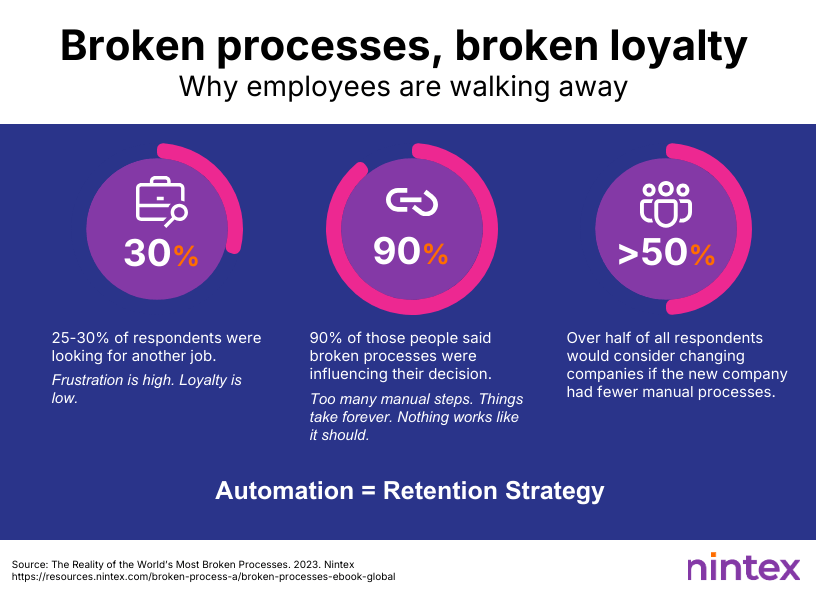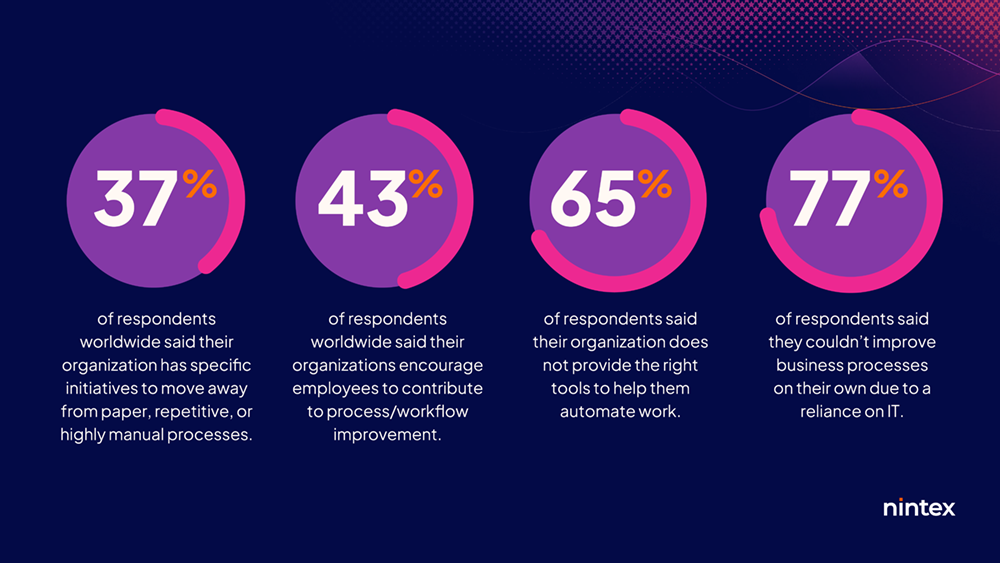Many organizations know that their processes could benefit from a little TLC. With the rise of remote and hybrid working, it has become essential to modernize IT systems, improve business processes, and overcome any barriers to productivity. But identifying which processes in an organization are broken is another matter entirely. By examining worldwide and national trends, you can get a good idea about where to start looking.
We conducted a survey to explore the state of business processes at organizations across the globe. The goal: to identify the world’s most broken processes. This is what we discovered.
Process matters to people

- 25-30% of respondents were looking for another job.
- 90% of those people said broken processes were influencing their decision.
- Over half of all respondents would consider changing companies if the new company had fewer manual processes.
The top ten broken processes
COVID-19 created a “perfect storm” for organizations everywhere. Those that had already invested heavily in digital processes were able to deal better with the disruption. But those reliant on manual, paper-based processes were far more likely to struggle. The sudden need to support remote and dispersed workforces tested digital IT infrastructure to the limit.
It’s perhaps no surprise then that, in 2021’s report, the most broken processes fall under the remit of IT, HR, and other pandemic-related issues, such as work from home requests.
The ten most reported broken processes were:
- Employee administrative processes
- Employee onboarding
- Work from home processes and requests
- COVID-19 and/or health check processes
- Contract processes
- Customer/client/patient service or support processes
- Inventory management processes
- Finance and accounting processes
- Compliance and regulatory processes
- Customer/client/patient onboarding processes
Now let’s see what respondents said about the departments most responsible for broken processes.
Download the report for more insights about broken processes in an organization and get a better idea of where and how to improve business processes.IT and HR under fire
More respondents singled out IT as a source of broken processes than any other department. This could be due to the strains that IT departments were operating under during the pandemic. Regardless, it’s worth noting that 77% of respondents said IT was a barrier to process improvement. And 73% said that IT impedes their organization’s ability to efficiently automate tasks and processes. Often this is due to a lack of tools and training for line of business teams to drive their own digital transformation projects.
The HR department was also identified as an area rife with broken processes in an organization. 41% of respondents reported employee administrative processes (e.g., raise negotiations, time off requests etc.) as the most broken.
What are organizations doing about it
There are some good signs, particularly in the United States, where a significant proportion of respondents said they had faith in their organization’s commitment to improve business processes.
- 43% of all respondents worldwide said their organizations encourage employees to contribute to process/workflow improvement.
- 37% of respondents worldwide said their organization has specific initiatives to move away from paper, repetitive, or highly manual processes.
But more needs to be done. 65% of respondents said their organization does not provide the right tools to help them automate work. And 77% said they couldn’t improve business processes on their own due to a reliance on IT.

How to fix broken processes in an organization
Organizations across the world are taking steps toward improving business processes, but there are significant areas of the enterprise where broken processes remain common. Although organizations are more switched on to the need to better manage, automate, and optimize processes, the signs show that IT remains a barrier for line of business workers trying to drive digital change.
You can read the full report here.
Nintex provides the full range of process automation solutions—from workflow automation and RPA to document generation, and much more. With low-code functionality, line of business workers without IT expertise can automate processes and initiate digital transformation projects.
To learn more about how to improve business processes and how to automate the broken processes in an organization, get in contact with the Nintex team today.
